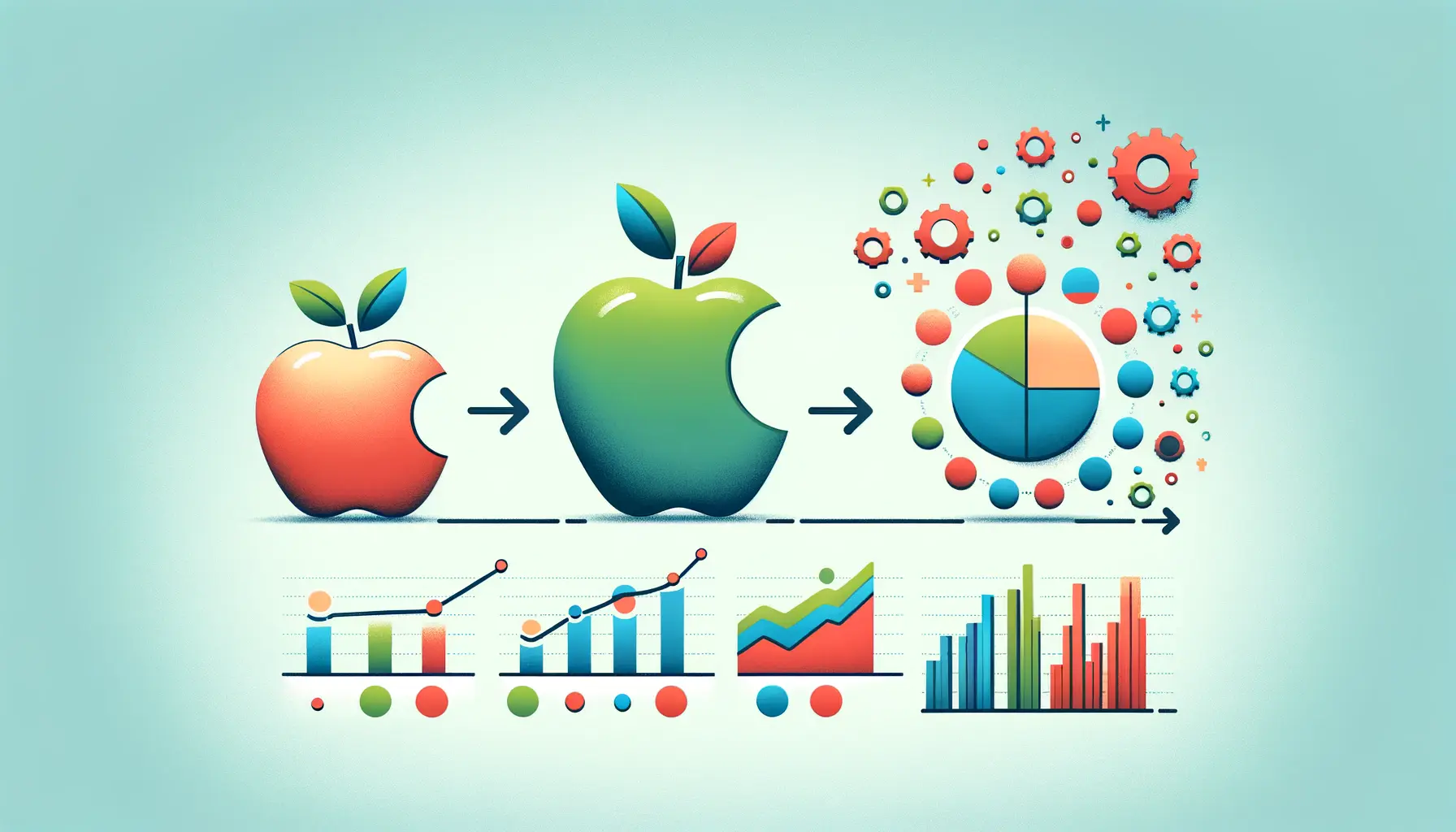The digital landscape has witnessed a transformative journey, especially in the realm of search advertising.
At the heart of this evolution lies Apple, a tech giant that has redefined the parameters of app marketing through its innovative platform, Apple Search Ads.
This platform has not only revolutionized how apps are discovered but has also set new benchmarks for campaign optimization, making it a critical tool for marketers aiming to excel in the highly competitive digital ecosystem.
Understanding the evolution of search advertising on Apple requires a deep dive into the mechanisms that drive Apple Search Ads and how they have adapted over time.
The platform’s unique approach to connecting users with relevant apps through search queries has opened new avenues for targeted advertising, making it indispensable for developers and marketers alike.
As we explore this journey, it becomes evident that Apple’s innovations in search advertising have not only enhanced user experience but have also provided marketers with unparalleled opportunities for growth and engagement.
- Introduction to Apple Search Ads
- Optimizing Campaigns with Apple Search Ads
- Understanding Audience Targeting and Segmentation
- Advanced Features for Campaign Success
- Measuring and Analyzing Campaign Performance
- Staying Ahead with Search Advertising Trends
- Future Directions for Apple Search Ads
- Embracing the Evolution of Search Advertising on Apple
- FAQs on Apple Search Advertising
Introduction to Apple Search Ads
Apple Search Ads, introduced in 2016, marked a significant milestone in the evolution of search advertising on the Apple App Store.
This platform allowed developers to promote their apps at the top of App Store search results, ensuring higher visibility and engagement from potential users.
The inception of Apple Search Ads was a response to the growing need for a more efficient way for app discovery, amidst the millions of apps available on the App Store.
The platform operates on a cost-per-tap (CPT) model, where advertisers pay only when a user taps on their ad.
This model not only ensures that advertisers get value for their investment but also aligns with the user’s interest, as ads are shown based on relevance to search queries.
Over the years, Apple Search Ads has evolved, introducing advanced features like keyword matching and audience targeting, which have further refined the platform’s effectiveness in reaching the right users.
Key Features and Benefits
One of the standout features of Apple Search Ads is its simplicity and effectiveness.
By allowing ads to appear in App Store search results, it ensures that apps are discovered by users at the moment they are looking for them.
This immediacy and relevance of app discovery are unparalleled, making it a highly effective platform for app promotion.
Furthermore, Apple Search Ads offers a range of targeting options, from keyword selection to demographic targeting, enabling advertisers to refine their audience and reach users most likely to be interested in their apps.
This level of targeting precision not only improves the efficiency of advertising campaigns but also enhances the user experience by connecting them with apps that match their interests and needs.
Apple Search Ads has significantly impacted how users discover apps on the App Store, making it a pivotal platform for developers and marketers aiming for visibility and engagement.
As we delve deeper into the evolution of search advertising on Apple, it’s clear that Apple Search Ads has been at the forefront of this transformation.
Its introduction and subsequent enhancements have not only changed the landscape of app marketing but have also set new standards for what effective search advertising should look like in the digital age.
Optimizing Campaigns with Apple Search Ads
The effectiveness of Apple Search Ads lies not just in its ability to place apps in front of potential users but also in the sophisticated tools it offers for campaign optimization.
Marketers and developers have at their disposal a suite of features designed to fine-tune their advertising efforts, ensuring that their apps reach the most relevant audience with precision.
This part of the article delves into the strategies and practices for optimizing campaigns within the Apple Search Ads ecosystem.
Optimization strategies for Apple Search Ads are multifaceted, involving keyword selection, bid adjustments, and audience targeting.
These elements work in tandem to enhance the visibility and engagement of app ads, making campaign optimization a critical aspect of success on the platform.
Keyword Selection and Management
Keywords are the cornerstone of any successful search advertising campaign, and Apple Search Ads is no exception.
Selecting the right keywords involves understanding the search behavior of your target audience and aligning your keywords with those search queries.
It’s not just about choosing the most popular keywords but finding the right balance between relevance, competition, and search volume.
- Exact Match Keywords: Targeting users who search for a specific phrase or keyword, ensuring high relevance.
- Broad Match Keywords: Reaching a wider audience by showing your ad for similar search queries, including synonyms and related terms.
- Negative Keywords: Excluding certain terms to prevent your ad from appearing in unrelated search queries, enhancing the efficiency of your ad spend.
Adjusting Bids for Optimal Placement
Bid adjustments are a critical tool in the Apple Search Ads toolkit, allowing advertisers to influence where and how prominently their ads are displayed.
By adjusting bids based on keyword performance, competition, and budget constraints, advertisers can optimize their ad placement to maximize visibility and engagement.
This dynamic approach to bidding requires continuous monitoring and adjustment to stay ahead in a competitive market.
Effective bid management involves understanding the competitive landscape for your chosen keywords and adjusting your bids to achieve the desired ad placement.
It’s a balance between cost-efficiency and visibility, ensuring that your ads reach your target audience without overspending.
Regularly reviewing and adjusting your keyword strategy and bids is essential for maintaining the effectiveness of your Apple Search Ads campaigns.
In conclusion, optimizing campaigns on Apple Search Ads requires a strategic approach to keyword selection, bid management, and audience targeting.
By leveraging the platform’s tools and features, advertisers can create highly targeted and effective advertising campaigns that drive app discovery and engagement.
Understanding Audience Targeting and Segmentation
Audience targeting and segmentation are pivotal in maximizing the efficiency of search advertising campaigns on Apple.
These strategies enable advertisers to tailor their campaigns to specific user groups, enhancing the relevance and effectiveness of their ads.
By understanding and implementing advanced audience targeting techniques, advertisers can significantly improve their campaign performance on Apple Search Ads.
The ability to segment audiences based on various criteria, such as demographics, app usage, and user behavior, allows for a more personalized advertising approach.
This personalization is key to engaging potential users and driving conversions.
Demographic Targeting
Demographic targeting involves reaching users based on age, gender, location, and language preferences.
This level of targeting ensures that your ads are seen by the segment of the population most likely to be interested in your app.
For instance, a fitness app might target users within a specific age range and location to maximize its relevance and appeal.
- Age and Gender: Tailor your ads to appeal to specific age groups and genders, depending on the primary audience of your app.
- Location: Focus your advertising efforts on geographic areas where your app is most likely to be used or needed.
- Language: Target users based on their language preferences to ensure your ad communicates effectively.
Behavioral and App Usage Targeting
Going beyond demographics, Apple Search Ads allows for targeting based on user behavior and app usage patterns.
This includes targeting users who have shown interest in similar apps or categories, as well as those who exhibit certain usage behaviors.
Such targeting can significantly increase the chances of your ad resonating with potential users, as it is based on their past actions and preferences.
- Similar App Users: Target users who have downloaded or shown interest in apps similar to yours, indicating a predisposed interest.
- User Behavior: Focus on users who exhibit specific behaviors that align with your app’s usage, such as frequent online shopping or gaming.
Incorporating advanced audience targeting and segmentation strategies into your Apple Search Ads campaigns can lead to higher engagement rates and more efficient use of your advertising budget.
Effective audience targeting and segmentation are not static but require ongoing analysis and refinement.
By continuously analyzing the performance of your campaigns and adjusting your targeting criteria, you can ensure that your ads remain relevant and effective over time.
This dynamic approach to audience targeting is essential for staying competitive in the ever-evolving app market.
Advanced Features for Campaign Success
Apple Search Ads offers a suite of advanced features designed to enhance campaign performance and provide advertisers with greater control and insight into their ad campaigns.
These features, ranging from creative sets to automation tools, enable a more customized and efficient approach to search advertising on Apple’s platform.
Understanding and leveraging these advanced features can significantly impact the success of your campaigns.
By diving into these advanced features, advertisers can unlock new levels of optimization and effectiveness in their Apple Search Ads campaigns, ensuring that they not only reach their target audience but also achieve their marketing objectives with greater precision.
Creative Sets and Customization
Creative sets allow advertisers to tailor their ad creatives based on the keywords and audience segments they are targeting.
This customization ensures that the ad creatives are as relevant as possible to the search queries and user interests, potentially increasing the ad’s click-through and conversion rates.
By using different images and text for different audience segments or search contexts, advertisers can significantly enhance the appeal and effectiveness of their ads.
- Ad Variations: Test different ad creatives to determine which combinations perform best in terms of engagement and conversions.
- Targeted Messaging: Customize your ad’s message to match the search intent and interests of your target audience, making it more compelling and relevant.
Automation and Bid Strategies
Automation tools within Apple Search Ads simplify the management of campaigns by allowing advertisers to set specific goals and parameters for their ads, such as target cost-per-acquisition (CPA) or return on investment (ROI).
The platform then automatically adjusts bids and targeting to meet these objectives, saving time and optimizing campaign performance.
This feature is particularly useful for advertisers managing multiple campaigns or those looking to maximize efficiency in their advertising efforts.
- Automated Bidding: Set your desired outcome, and let the system automatically adjust bids to achieve your campaign goals.
- Performance Monitoring: Use Apple Search Ads’ analytics tools to track the performance of your campaigns and make data-driven decisions.
Leveraging advanced features like creative sets and automation can lead to more personalized, efficient, and effective advertising campaigns on Apple Search Ads.
These advanced features of Apple Search Ads not only offer the potential for enhanced campaign performance but also provide advertisers with the tools needed to navigate the complexities of app marketing in today’s digital landscape.
By embracing these features, advertisers can create more targeted, engaging, and successful advertising campaigns, driving app discovery and downloads in the competitive App Store environment.
Measuring and Analyzing Campaign Performance
Success in search advertising on Apple’s platform is not just about setting up campaigns but also about continuously measuring and analyzing their performance.
Apple Search Ads provides a comprehensive set of analytics tools that enable advertisers to track key performance indicators (KPIs), such as impressions, clicks, conversion rates, and more.
Understanding these metrics is crucial for optimizing campaigns and ensuring the highest return on investment (ROI).
Effective measurement and analysis allow advertisers to make informed decisions, fine-tune their strategies, and identify areas for improvement.
This ongoing process of optimization is what ultimately leads to successful advertising campaigns on Apple Search Ads.
Key Performance Indicators (KPIs)
Monitoring the right KPIs is essential for assessing the effectiveness of your Apple Search Ads campaigns.
These metrics provide insights into how well your ads are performing in terms of visibility, engagement, and conversions.
Some of the most important KPIs to track include:
- Impressions: The number of times your ads were shown, indicating the reach of your campaign.
- Clicks: How often your ads were clicked, reflecting user interest and engagement.
- Conversion Rate: The percentage of clicks that resulted in an app download, showing the effectiveness of your ads in driving actions.
- Cost Per Acquisition (CPA): The average cost of acquiring a new user through your ads, a critical metric for budgeting and ROI calculations.
Optimization Strategies Based on Analytics
With access to detailed performance data, advertisers can implement targeted optimization strategies to improve their campaign results.
This might involve adjusting keyword strategies, refining audience targeting, or revising bid amounts based on the insights gained from performance analytics.
The goal is to continually refine your approach to maximize efficiency and effectiveness.
- Keyword Refinement: Analyze which keywords are driving the most conversions and adjust your strategy accordingly.
- Audience Retargeting: Use performance data to identify the most responsive audience segments and tailor your campaigns to better meet their needs.
- Bid Adjustments: Optimize your bids based on the performance of individual keywords and ad placements to ensure competitive visibility without overspending.
Regular analysis of campaign performance and strategic adjustments based on data insights are key to achieving and maintaining success in Apple Search Ads.
By leveraging the analytics tools provided by Apple Search Ads, advertisers can gain a deep understanding of their campaign performance, enabling them to make data-driven decisions that enhance the effectiveness of their search advertising efforts.
This analytical approach is essential for staying competitive in the dynamic and crowded App Store environment.
Staying Ahead with Search Advertising Trends
In the fast-paced world of digital marketing, staying informed about the latest trends in search advertising is crucial for maintaining a competitive edge.
This is especially true for Apple Search Ads, where the landscape is constantly evolving with new features, consumer behaviors, and technological advancements.
Advertisers who stay ahead of these trends can better adapt their strategies to meet the changing demands of the market and capitalize on new opportunities for growth.
Understanding and leveraging the latest trends in search advertising can help advertisers optimize their campaigns on Apple’s platform, ensuring they remain relevant and effective in attracting and engaging their target audience.
Emerging Technologies and Innovations
The integration of emerging technologies, such as artificial intelligence (AI) and machine learning, into search advertising platforms is transforming how campaigns are managed and optimized.
These technologies enable more sophisticated targeting and bidding strategies, improving the efficiency and effectiveness of ad campaigns.
Advertisers who embrace these innovations can gain a significant advantage in the highly competitive app market.
- AI-Powered Optimization: Utilize AI to automate and optimize bidding strategies and ad placements, ensuring maximum ROI.
- Machine Learning Insights: Leverage machine learning algorithms to gain deeper insights into user behavior and preferences, enabling more targeted and personalized ad campaigns.
Privacy Regulations and User Consent
With increasing concerns over privacy and data protection, regulations such as the General Data Protection Regulation (GDPR) and changes to device-level tracking have significant implications for search advertising.
Advertisers must navigate these challenges by adopting privacy-compliant strategies that still allow for effective targeting and personalization.
Staying informed about privacy trends and regulations is essential for developing campaigns that respect user consent while achieving marketing objectives.
- User Consent Management: Implement strategies to manage user consent effectively, ensuring compliance with privacy regulations.
- Privacy-Friendly Targeting: Explore alternative targeting methods that do not rely on personal data, such as contextual targeting, to maintain campaign effectiveness.
Ignoring the impact of privacy regulations and technological advancements on search advertising can lead to missed opportunities and potential compliance issues.
By staying attuned to the latest trends and innovations in search advertising, advertisers can ensure their Apple Search Ads campaigns are not only compliant with current regulations but also optimized for maximum performance.
This proactive approach to trend analysis and adaptation is key to thriving in the dynamic landscape of digital marketing.
Future Directions for Apple Search Ads
The trajectory of Apple Search Ads suggests a future where the platform continues to evolve, incorporating more advanced technologies and offering even more sophisticated targeting and optimization capabilities.
As Apple further integrates user privacy and data protection into its ecosystem, advertisers will need to adapt their strategies to align with these priorities while still reaching their target audiences effectively.
The future of search advertising on Apple promises to be both challenging and exciting, with new opportunities for innovation and engagement.
Anticipating and preparing for these future developments is crucial for advertisers who wish to maintain and enhance their competitive advantage in the App Store.
The ability to adapt to changes in the platform and the broader digital advertising landscape will determine the success of search advertising campaigns in the years to come.
Enhanced Personalization and Targeting
As technologies like AI and machine learning become more integrated into Apple Search Ads, we can expect to see even more personalized and targeted advertising solutions.
These advancements will likely enable advertisers to understand and connect with their audiences in more meaningful ways, improving the relevance and effectiveness of their ads.
The challenge will be to balance this personalization with respect for user privacy, a core value for Apple and its users.
- Dynamic Creative Optimization: Tailor ad creatives in real-time based on user behavior and preferences for more engaging ad experiences.
- Predictive Targeting: Use predictive analytics to identify and target users who are most likely to be interested in specific apps, even before they search for them.
Adapting to Privacy-First Advertising
The emphasis on privacy and data protection is expected to continue shaping the future of Apple Search Ads.
Advertisers will need to find innovative ways to target and engage users without relying on invasive data collection practices.
This could involve more reliance on aggregated data, anonymized user segments, and contextual targeting strategies that respect user privacy while still delivering effective advertising.
- Contextual Targeting: Focus on the context in which ads are shown, rather than personal user data, to maintain relevance and engagement.
- Privacy-Compliant Analytics: Develop analytics approaches that provide valuable insights without compromising user privacy.
Embracing the future of Apple Search Ads requires a commitment to innovation, privacy, and user-centric advertising. By anticipating and adapting to these trends, advertisers can continue to achieve success on the platform while respecting the evolving expectations of users and regulators.
The future of Apple Search Ads is poised for significant growth and transformation.
Advertisers who stay informed, adapt to new technologies, and prioritize user privacy will be well-positioned to leverage the platform’s full potential, driving app discovery and engagement in an increasingly competitive digital landscape.
Embracing the Evolution of Search Advertising on Apple
The journey through the evolution of search advertising on Apple reveals a landscape marked by innovation, strategic optimization, and an unwavering focus on user experience.
As we’ve explored the intricacies of Apple Search Ads, from its foundational features to the advanced strategies that drive campaign success, it’s clear that this platform offers a unique and powerful avenue for app marketers to connect with their target audiences.
The continuous evolution of search advertising on Apple underscores the importance of staying ahead of technological advancements, privacy regulations, and market trends to leverage the full potential of this platform.
Key Takeaways for Advertisers
Advertisers navigating the Apple Search Ads environment must prioritize a deep understanding of their audience, leveraging advanced targeting and segmentation to craft campaigns that resonate on a personal level.
The adoption of creative sets, automation, and bid strategies further enhances the ability to reach potential users with precision and efficiency.
Moreover, the critical role of analytics in measuring and optimizing campaign performance cannot be overstated, providing the insights necessary to refine and adapt strategies in real-time.
Looking Ahead: The Future of Search Advertising on Apple
The future of search advertising on Apple is poised for continued growth and innovation.
Advertisers must remain agile, ready to embrace new technologies and methodologies that promise to enhance personalization and targeting while navigating the complexities of a privacy-first digital landscape.
The balance between personalization and privacy will define the next era of search advertising on Apple, challenging advertisers to innovate while respecting user consent and data protection.
- The integration of AI and machine learning for dynamic creative optimization and predictive targeting.
- Adapting strategies to comply with evolving privacy regulations and user expectations.
- Exploring new avenues for engagement through contextual and privacy-compliant targeting methods.
In conclusion, the evolution of search advertising on Apple offers both challenges and opportunities for advertisers.
By embracing the platform’s advanced features, staying informed about industry trends, and prioritizing user privacy, marketers can navigate this evolving landscape successfully.
The future of search advertising on Apple is bright, with endless possibilities for those willing to innovate and adapt.
As we move forward, the key to success lies in creating advertising experiences that are not only effective but also respectful of the user’s digital journey.
If you're seeking expertise in Apple Search Ads campaigns, visit our service page for professional management!
FAQs on Apple Search Advertising
Explore common queries about Apple Search Ads to enhance your app promotion strategy.
Apple Search Ads is a platform allowing advertisers to promote apps at the top of App Store search results, enhancing visibility and downloads.
Advertisers bid on keywords relevant to their app, and winning ads appear at the top of App Store search results for those keywords.
Benefits include increased app visibility, higher download rates, and the ability to target potential users actively searching for related apps.
Yes, Apple Search Ads offers advanced targeting options based on user demographics, behaviors, and app preferences for more personalized advertising.
Costs are based on a cost-per-tap (CPT) model, where advertisers pay only when a user taps on their ad, with bids determining ad placement.
Success can be measured using key performance indicators (KPIs) provided by Apple, such as impressions, clicks, conversion rates, and CPA.
Best practices include using relevant keywords, optimizing bid amounts, targeting the right audience, and continuously analyzing and adjusting campaigns.
Apple prioritizes user privacy, requiring advertisers to adhere to strict guidelines ensuring ads are relevant without compromising user data security.













